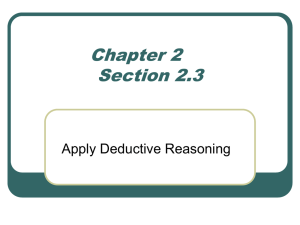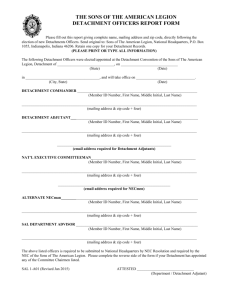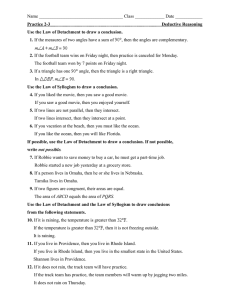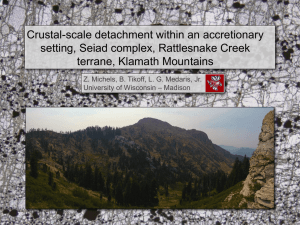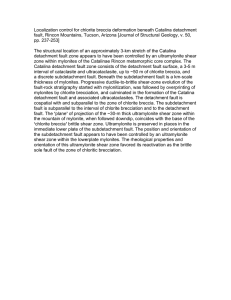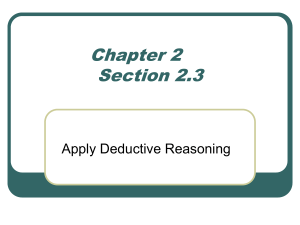Large, coherent, submarine landslide associated with Pan-African foreland flexure Paul F. Hoffman
advertisement
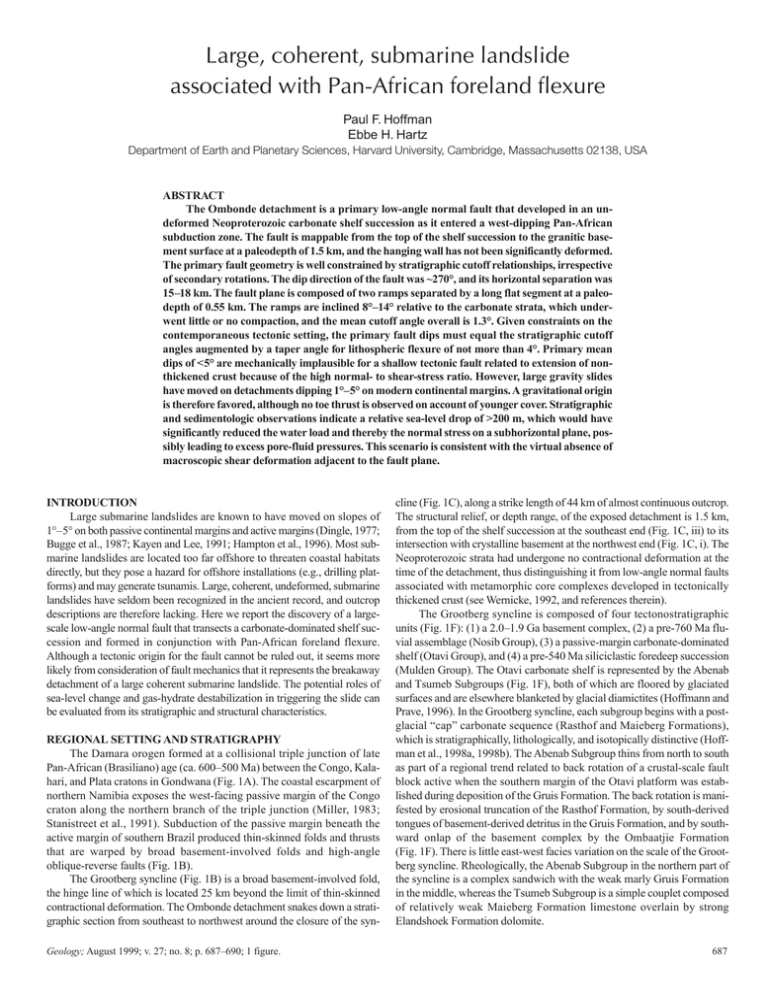
Large, coherent, submarine landslide associated with Pan-African foreland flexure Paul F. Hoffman Ebbe H. Hartz Department of Earth and Planetary Sciences, Harvard University, Cambridge, Massachusetts 02138, USA ABSTRACT The Ombonde detachment is a primary low-angle normal fault that developed in an undeformed Neoproterozoic carbonate shelf succession as it entered a west-dipping Pan-African subduction zone. The fault is mappable from the top of the shelf succession to the granitic basement surface at a paleodepth of 1.5 km, and the hanging wall has not been significantly deformed. The primary fault geometry is well constrained by stratigraphic cutoff relationships, irrespective of secondary rotations. The dip direction of the fault was ~270°, and its horizontal separation was 15–18 km. The fault plane is composed of two ramps separated by a long flat segment at a paleodepth of 0.55 km. The ramps are inclined 8°–14° relative to the carbonate strata, which underwent little or no compaction, and the mean cutoff angle overall is 1.3°. Given constraints on the contemporaneous tectonic setting, the primary fault dips must equal the stratigraphic cutoff angles augmented by a taper angle for lithospheric flexure of not more than 4°. Primary mean dips of <5° are mechanically implausible for a shallow tectonic fault related to extension of nonthickened crust because of the high normal- to shear-stress ratio. However, large gravity slides have moved on detachments dipping 1°–5° on modern continental margins. A gravitational origin is therefore favored, although no toe thrust is observed on account of younger cover. Stratigraphic and sedimentologic observations indicate a relative sea-level drop of >200 m, which would have significantly reduced the water load and thereby the normal stress on a subhorizontal plane, possibly leading to excess pore-fluid pressures. This scenario is consistent with the virtual absence of macroscopic shear deformation adjacent to the fault plane. INTRODUCTION Large submarine landslides are known to have moved on slopes of 1°–5° on both passive continental margins and active margins (Dingle, 1977; Bugge et al., 1987; Kayen and Lee, 1991; Hampton et al., 1996). Most submarine landslides are located too far offshore to threaten coastal habitats directly, but they pose a hazard for offshore installations (e.g., drilling platforms) and may generate tsunamis. Large, coherent, undeformed, submarine landslides have seldom been recognized in the ancient record, and outcrop descriptions are therefore lacking. Here we report the discovery of a largescale low-angle normal fault that transects a carbonate-dominated shelf succession and formed in conjunction with Pan-African foreland flexure. Although a tectonic origin for the fault cannot be ruled out, it seems more likely from consideration of fault mechanics that it represents the breakaway detachment of a large coherent submarine landslide. The potential roles of sea-level change and gas-hydrate destabilization in triggering the slide can be evaluated from its stratigraphic and structural characteristics. REGIONAL SETTING AND STRATIGRAPHY The Damara orogen formed at a collisional triple junction of late Pan-African (Brasiliano) age (ca. 600–500 Ma) between the Congo, Kalahari, and Plata cratons in Gondwana (Fig. 1A). The coastal escarpment of northern Namibia exposes the west-facing passive margin of the Congo craton along the northern branch of the triple junction (Miller, 1983; Stanistreet et al., 1991). Subduction of the passive margin beneath the active margin of southern Brazil produced thin-skinned folds and thrusts that are warped by broad basement-involved folds and high-angle oblique-reverse faults (Fig. 1B). The Grootberg syncline (Fig. 1B) is a broad basement-involved fold, the hinge line of which is located 25 km beyond the limit of thin-skinned contractional deformation. The Ombonde detachment snakes down a stratigraphic section from southeast to northwest around the closure of the synGeology; August 1999; v. 27; no. 8; p. 687–690; 1 figure. cline (Fig. 1C), along a strike length of 44 km of almost continuous outcrop. The structural relief, or depth range, of the exposed detachment is 1.5 km, from the top of the shelf succession at the southeast end (Fig. 1C, iii) to its intersection with crystalline basement at the northwest end (Fig. 1C, i). The Neoproterozoic strata had undergone no contractional deformation at the time of the detachment, thus distinguishing it from low-angle normal faults associated with metamorphic core complexes developed in tectonically thickened crust (see Wernicke, 1992, and references therein). The Grootberg syncline is composed of four tectonostratigraphic units (Fig. 1F): (1) a 2.0–1.9 Ga basement complex, (2) a pre-760 Ma fluvial assemblage (Nosib Group), (3) a passive-margin carbonate-dominated shelf (Otavi Group), and (4) a pre-540 Ma siliciclastic foredeep succession (Mulden Group). The Otavi carbonate shelf is represented by the Abenab and Tsumeb Subgroups (Fig. 1F), both of which are floored by glaciated surfaces and are elsewhere blanketed by glacial diamictites (Hoffmann and Prave, 1996). In the Grootberg syncline, each subgroup begins with a postglacial “cap” carbonate sequence (Rasthof and Maieberg Formations), which is stratigraphically, lithologically, and isotopically distinctive (Hoffman et al., 1998a, 1998b). The Abenab Subgroup thins from north to south as part of a regional trend related to back rotation of a crustal-scale fault block active when the southern margin of the Otavi platform was established during deposition of the Gruis Formation. The back rotation is manifested by erosional truncation of the Rasthof Formation, by south-derived tongues of basement-derived detritus in the Gruis Formation, and by southward onlap of the basement complex by the Ombaatjie Formation (Fig. 1F). There is little east-west facies variation on the scale of the Grootberg syncline. Rheologically, the Abenab Subgroup in the northern part of the syncline is a complex sandwich with the weak marly Gruis Formation in the middle, whereas the Tsumeb Subgroup is a simple couplet composed of relatively weak Maieberg Formation limestone overlain by strong Elandshoek Formation dolomite. 687 FAULT GEOMETRY, CUTOFF ANGLES, AND SEPARATIONS In outcrop, the detachment is typically a smooth planar fault, oriented subparallel to bedding and having <5 cm of cataclasite or sheared rock. It is characterized by the omission of 200–400 m of stratigraphic section at all structural levels, implying an overall normal sense of slip. The detachment is commonly a single fault, but a 2.5-km-long extensional horse occurs at the exposed keel of the syncline and smaller horses occur elsewhere (Fig. 1C). Slickensides are rarely observable in carbonate outcrops because of karstification, and kinematic analysis of vein systems is complicated by younger strains related to the Grootberg syncline. Fortunately, stratigraphic cutoffs can be precisely located (Fig. 1H) and are used to constrain the direction and magnitude of fault separation. The most informative sets of stratigraphic cutoffs occur in the eaststriking segment of the outcrop belt west of the synclinal axis (Fig. 1, C [i] and H), where the detachment cuts downsection from east to west in both the footwall and hanging wall. The hanging wall cuts down from the lower Elandshoek Formation to the lower Rasthof Formation, and the footwall from the middle Gruis Formation through the Nosib Group to the basement granite (Fig. 1C, ii). The hanging-wall cutoff at the base of the Elandshoek Formation is exposed in two places, owing to second-order, open, crossfolding of the detachment (Fig. 1C, ii). The cutoff trends 357°, implying a contemporaneous dip direction of 267° for the detachment at this location. A dip direction of 270° ± 10° is required by the distribution of cutoffs throughout the syncline in order for the detachment to ramp continuously downsection. Because stratigraphic thicknesses are known from measured sections (Fig. 1F) and compaction in the carbonate rocks is virtually zero, primary cutoff angles, defined as the angles between the detachment surface and various stratigraphic horizons, can be calculated (Fig. 1D). An average footwall cutoff angle (θ) of 14° is calculated for the Rasthof Formation, and hanging-wall cutoff angles, averaged through the Ombaatjie and Maieberg Formations, are 10° and 9°, respectively. It is noteworthy that the hanging wall is unextended in the area where the outcrop belt parallels the inferred slip direction (Fig. 1C, i). The average cutoff angle for the entire Abenab Subgroup, including the long “flat” in the Gruis Formation, can also be calculated. The footwall cutoff of the base of the subgroup is located very close to the hanging-wall cutoff of the top of the subgroup (Fig. 1H). Given a stratigraphic thickness of 395 m for the subgroup and an estimated horizontal separation, or heave, of 17.3 km between the footwall and hanging-wall cutoffs of the top of the subgroup, the average cutoff angle through the entire subgroup is calculated to be a mere 1.3° (Fig. 1, D and E). Where are the footwall cutoffs equivalent to the hanging-wall cutoffs described here? Around the northern closure of the syncline, the detachment was nearly flat, placing the middle Elandshoek Formation in the hanging wall over the middle Gruis Formation in the footwall, except for the horse of Ombaatjie Formation at the keel of the syncline. On the east limb of the syncline, the detachment ramps upsection in the footwall. If it is assumed that the detachment dipped due west, calculated average cutoff angles through the Ombaatjie and Maieberg Formations are 8° and 9.5°, respectively, comparable to their hanging-wall equivalents. The horizontal separations of equivalent footwall and hanging-wall cutoffs are 17.3, 16.4, and 16.0 km for the tops of the Gruis, Ombaatjie, and Maieberg Formations, respectively. Because profiles of the syncline indicate ~0.5% of east-west shortening, the west-directed components of slip for the respective pairs of footwall and hanging-wall cutoffs are 18.2, 17.3, and 16.8 km (Fig. 1E). If the horse of Ombaatjie Formation exposed at the syncline axis is projected onto the line of section (Fig. 1E), the separation of that unit would be reduced by ~2.5 km. TIMING, TECTONIC SETTING, AND PRIMARY DIPS The age of fault movement is constrained by incised paleovalleys, lined by locally derived dolomite-chert breccias and boulder conglomerates of the Mulden Group, which were eroded through the hanging wall of the detachment and into the footwall. The largest paleovalley occurs in the 688 northeast-striking segment of the outcrop belt west of the synclinal axis (Fig. 1C, ii). The paleovalley crosses the detachment without offset, showing clearly that fault movement was complete before the paleovalley was filled. In the southeast part of the area, the detachment is cut by a set of younger high-angle faults, on which sinistral-oblique reverse movements are inferred. Despite local rotations related to the younger fault set, the detachment is observed to climb upsection to the contemporaneous erosion surface at the top of the Elandshoek Formation (Fig. 1E). Small paleovalleys filled by Mulden Group conglomerate are eroded through the hanging wall and down to the detachment surface. Therefore, movement on the detachment postdated the youngest passive-margin carbonates and predated the locally oldest sediments of the foredeep. If detachment faulting occurred in conjunction with foreland flexure, the primary westward dip of the fault should combine the stratigraphic cutoff angles (i.e., 1.3° overall and 14° for the steepest ramp segment) with an appropriate lithospheric flexure or taper angle. The taper of a foreland basin depends on the flexural rigidity of the lithosphere, then >1 Ga, and on the tectonic load. The tectonic load is difficult to estimate, but the relatively fine grained facies of the foreland-basin fill (Stanistreet et al., 1991), excepting the colluvial deposits lining the paleovalleys, suggests an absence of proximal high topographic loads. A taper angle exceeding 4° is highly improbable (Lorenzo et al., 1998). Accordingly, the primary dip of the detachment was <5° overall and was <13° and <18° for the upper and lower ramp segments, respectively. DISCUSSION Is the detachment a tectonic fault rooted in the crystalline basement, or does its downdip extension ramp back up through the Otavi Group as the toe thrust of a superficial slide mass? Mapping of the detachment directly west of the Grootberg syncline is precluded by Cretaceous volcanic cover, and no west-vergent thrust with displacement comparable to the detachment was found in the belt northwest of the syncline (Fig. 1B). However, normal faults of tectonic origin developed close to the Earth’s surface in nonthickened crust should not have primary dips of <30°, according to simple Andersonian fault mechanics, and the normal stress acting on the detachment (dipping <5°) was at least 10 times the shear stress (sin 85°/cos 85° = 0.087). The focal planes of normal-fault earthquakes defined by waveform modeling rarely dip <30° (Wernicke, 1995, and references therein), and most low-angle normal faults of tectonic origin observed geologically (Wernicke, 1992) or seismologically (Abers, 1991) are associated with metamorphic core complexes developed in regions of tectonically thickened crust. Therefore, we consider the possibility that the detachment is a rootless structure, despite the absence of an observed toe. By suggesting that the hanging wall at the toe of the detachment displaced water rather than rock, the overall enigma of the structure is partly solved, but the lack of internal deformation in the hanging wall must still be explained. Given its tectonic setting on the lower plate of a west-dipping subduction zone and its westward-directed sense of displacement, the hanging wall of the detachment can only have moved as a gravity slide between the crest of the forebulge and the trench (foredeep) axis. If faulting had occurred before reaching the crest of the forebulge, gravitational sliding would have been directed eastward, contrary to observation. The seaward dip of the foredeep outer slope would rotate σ1 from vertical to a steep westward plunge, thereby also decreasing normal stress and increasing shear stress on the detachment. The setting of fault movement is important for considering possible triggering mechanisms. Any suitable triggering mechanism must increase the downslope driving stress and/or decrease the shear resistance (Hampton et al., 1996). The former can be achieved by seismic activity, or by sediment or storm-wave loading, and the latter by excess pore-fluid pressure. The setting envisioned for the detachment would be prone to earthquakes which relieve stresses generated by the bending and unbending of the subducting plate. Sediment loading would not be a factor on the sediment-starved outer slope of the foredeep, and storm-wave loading would be GEOLOGY, August 1999 Figure 1. Geologic setting of Ombonde detachment. A: Location of Grootberg syncline (small red box) in northwestern Namibia (red line) (key: 1, cratons [Pl, Plata; Kal, Kalahari; and Congo]; 2, Pan-African orogens; 3, Phanerozoic orogens). B: Structural setting of Grootberg syncline between Pan-African thrust belt (barbed lines) and foreland basement inlier. C: Geologic map of Grootberg syncline. Box i: Hangingwall and footwall cutoffs in section subparallel to motion on detachment. Box ii: Truncation of detachment by paleovalley (PV) filled by Mulden conglomerate, which establishes pre-Mulden Group age for detachment. Box iii: Headwall paleoscarp of detachment at top of Elandshoek Formation. D: Schematic cross section of detachment showing calculated cutoff angle (θ) of 1.3° through Abenab Subgroup. E:Transverse cross section after motion on detachment but before folding of syncline, showing ramp-flat-ramp detachment geometry, postdetachment PV filled by Mulden conglomerate, and estimated 17.3 km of slip based on matching footwall and hanging-wall stratigraphic cutoffs. F: Generalized stratigraphy of Grootberg syncline based on measured sections MS1–MS6 (see C for locations). G: Model for development of detachment as submarine landslide. Panel x: West-facing passive continental margin about to enter westdipping subduction zone, showing trajectory of future detachment within nondisplaced shelf strata. Panel y: As continental margin descends outer slope of subduction zone, rapidly falling sea level (due to evaporative drawdown?) reduces water load, causing excess porefluid pressures in shelf strata. Outer shelf detaches and slides coherently downslope, shedding debris apron. Panel z: Continued fall in sea level leads to karstification of nondisplaced shelf carbonates and channel incision through displaced shelf sediments and basal detachment. Ultimately, displaced and nondisplaced shelf strata are buried in fluviatile foredeep sandstones of northerly derivation; foreland thrust-fold belt incorporates western quarter of cross section. H: Panorama of detachment (line with ticks) in area of C, ii (view looking south) showing mappability of stratigraphic cutoffs. limited by water depth. Water loading would have increased as the shelf descended into the foredeep, barring major eustatic changes, but this would be ineffective as a triggering mechanism because it would also increase the normal stress and hence also the shear resistance. It has often been suggested that submarine landslides are triggered by falls in relative sea level, which by reducing the effective normal stress may potentially result in gas-hydrate destabilization and consequent pore-fluid overpressures at the base of the gas-hydrate zone (Bugge et al., 1987; Kayen and Lee, 1991; Hampton et al., 1996). The base of the gas-hydrate zone is determined by the geothermal gradient and is typically 200–600 m below the sea floor. Therefore, gas-hydrate destabilization provides a possible GEOLOGY, August 1999 explanation for the long flat segment of the detachment at a paleodepth of ~550 m, but not for the lower ramp segment that reached a paleodepth of at least 1500 m (Fig. 1E). However, rapid sea-level falls can lead to pore-fluid overpressures in sediments of low permeability, independent of hydrates. The remarkable lack of macroscopic strain in rocks adjacent to the detachment is indicative of excess pore-fluid pressures. Moreover, if pore-fluid pressures within the sediment column approached hydrostatic prior to sealevel fall, reducing the water load would have caused the least-compressive stress axis to become vertical, thereby favoring low failure angles. For 550 m of water-saturated carbonate mud (density ~2.3 g/cm3, i.e., 12.4 MPa), a drop in water depth from 500 m (at time t0 ) to 300 m (t1) (saline water, 689 density ~1.1 g/cm3, i.e., 2.2 MPa), for example, would have lowered the vertical stress (σv) by ~12% from the relationship (σv [mud + water]t0 – σv [mud + water]t1)/σv (mud + water)t0 . Is there any independent evidence for a major sea-level fall concurrent with fault movement? The Mulden Group becomes younger from northwest to southeast owing to diachronous collision and tectonic progradation of the foredeep (Stanistreet et al., 1991). Northwest of the Grootberg syncline (Fig. 1B), the foredeep was filled by thin-bedded muds and silts with carbonate-chert debris flows deposited beneath standing water. In the Grootberg syncline, in contrast, the foredeep is dominated by fluviatile sandstones characterized by meter-scale trough cross-bedding. Deep paleovalleys at the base of the foredeep were eroded after fault movement (Fig. 1G) and are partly filled by colluvial dolomite-chert breccia and conglomerate. Although as much as a few tens of meters of fine-grained sediments underlie the fluviatile sandstones, they are not of sufficient thickness to shoal the foredeep in the absence of a major sea-level fall. Because foredeeps may become isolated from the ocean during continental collision and are therefore susceptible to desiccation, the postulated sea-level fall need not be global and may be of great magnitude, as occurred during the Messinian (late Miocene) evaporative drawdown of the Mediterranean Sea (Hsü et al., 1973). Such a sea-level fall is consistent with steep-walled paleovalleys having >200 m of local relief on the sub-Mulden Group unconformity elsewhere in the region (Frets, 1969, p. 103). CONCLUSIONS The Ombonde detachment is a sharply defined, normal fault that cuts down to the west through a Neoproterozoic carbonate-dominated shelf succession to a paleodepth of 1.5 km at an average primary cutoff angle of 1.3°. Fault separation of 15–18 km occurred during incipient continental collision as the passive-margin shelf descended the outer slope of a west-dipping subduction zone. Because of younger cover, it cannot be determined from mapping if the fault originated through tectonic extension (i.e., it is rooted in the lower plate) or as a large coherent submarine landslide (i.e., it toes out downdip). However, the very low primary cutoff angles are mechanically implausible for a normal fault of tectonic origin developed close to the Earth’s surface in nonthickened crust, and therefore the gravity-slide interpretation is preferred (Fig. 1G). The virtual absence of macroscopic deformation associated with the fault plane suggests excess pore-fluid pressures. If near-hydrostatic pressures existed in the sediment column, then a rapid fall in sea level (Fig. 1G, y) would render the least-compressive stress axis vertical, which would favor low failure angles. Circumstantial evidence for falling sea level around the time of the slide is provided by deeply incised paleovalleys (some of which cut the fault plane) at the base of the foredeep succession (Fig. 1G, z), as well as by the fluviatile origin of the foredeep fill. Concurrent gas-hydrate destabilization could have localized the long flat segment of the detachment observed at a paleodepth of ~550 m, but the deeper segment of the fault reaching 1.5 km paleodepth is well below the normal lower limit of gas hydrates determined by geothermal gradients. 690 ACKNOWLEDGMENTS The Ombonde detachment was first recognized in 1994 by A. Prave and D. Sumner on the east limb of the Grootberg syncline. Field work was supported by the Geological Survey of Namibia, University of Victoria, National Science and Engineering Research Council of Canada, Harvard University, and National Science Foundation grant EAR-95-06769. C. Carman and G. Halverson helped with the figures. E. Beutner, H. Porada, B. Wernicke, and three anonymous referees made valuable comments on earlier versions of the manuscript. REFERENCES CITED Abers, G. A., 1991, Possible seismogenic shallow-dipping normal faults in the Woodlark-D’Entrecasteaux extensional province, Papua New Guinea: Geology, v. 19, p. 1205–1208. Bugge, T., Befring, S., Belderson, R. H., Eidvin, T., Jansen, E., Kenyon, N. H., Holtedahl, H., and Sejrup, E., 1987, A giant three-stage submarine slide off Norway: Geo-Marine Letters, v. 7, p. 191–198. Dingle, R. V., 1977, The anatomy of a large submarine slump on a sheared continental margin (SE Africa): Geological Society of London Journal, v. 134, p. 293–310. Frets, D. C., 1969, Geology and structure of the Huab-Welwitschia area, South West Africa: University of Cape Town, Precambrian Research Unit Bulletin 5, 235 p. Hampton, M. A., Lee, H. J., and Locat, J., 1996, Submarine landslides: Reviews of Geophysics, v. 34, p. 33–59. Hoffman, P. F., Kaufman, A. J., and Halverson, G. P., 1998a, Comings and goings of global glaciations on a Neoproterozoic tropical platform in Namibia: GSA Today, v. 8, no. 5, p. 1–9. Hoffman, P. F., Kaufman, A. J., Halverson, G. P., and Schrag, D. P., 1998b, A Neoproterozoic snowball Earth: Science, v. 281, p. 1342–1346. Hoffmann, K.-H., and Prave, A. R., 1996, A preliminary note on a revised subdivision and regional correlation of the Otavi Group based on glaciogenic diamictites and associated cap dolostones: Geological Survey of Namibia Communications, v. 11, p. 77–82. Hsü, K. J., Ryan, W. B. F., and Cita, M. B., 1973, Late Miocene desiccation of the Mediterranean: Nature, v. 242, p. 240–244. Kayen, R. E., and Lee, H. J., 1991, Pleistocene slope instability of gas hydrate–laden sediment on the Beaufort Sea margin: Marine Geotechnology, v. 10, p. 125–141. Lorenzo, J. M., O’Brien, W. O., Stewart, J., and Tandon, K., 1998, Inelastic yielding and forebulge shape across a modern foreland basin: North west shelf of Australia, Timor Sea: Geophysical Research Letters, v. 25, p. 1455–1458. Miller, R. M., 1983, Evolution of the Damara orogen of South West Africa/Namibia: Geological Society of South Africa Special Publication 11, 515 p. Stanistreet, I. G., Kukla, P. A., and Henry, G., 1991, Sedimentary basinal responses to a late Precambrian Wilson cycle: The Damara orogen and Nama foreland, Namibia: Journal of African Earth Sciences, v. 13, p. 141–156. Wernicke, B., 1992, Cenozoic extension tectonics of the U.S. Cordillera, in Burchfiel, B. C., Lipman, P. W., and Zoback, M. L., eds., The Cordilleran orogen: The conterminous U.S.: Boulder, Colorado, Geological Society of America, Geology of North America, v. G3, p. 553–582. Wernicke, B., 1995, Low-angle normal faults and seismicity: A review: Journal of Geophysical Research, v. 100, p. 20,159–20,174. Manuscript received February 16, 1999 Revised manuscript received April 19, 1999 Manuscript accepted April 26, 1999 Printed in U.S.A. GEOLOGY, August 1999
